National Assembly (South Korea)
| National Assembly of South Korea 대한민국 국회 大韓民國國會 Daehan-min-guk Gukhoe | |
|---|---|
| 20th National Assembly | |
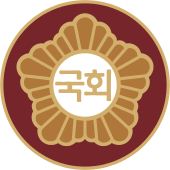 | |
| Type | |
| Type | |
| Leadership | |
Vice Speaker | |
Vice Speaker | |
| Structure | |
| Seats | 300 |
 | |
Political groups |
Government[2]
Opposition
|
Length of term | 4 years |
| Elections | |
| |
Last election | 13 April 2016 |
Next election | 15 April 2020 |
| Meeting place | |
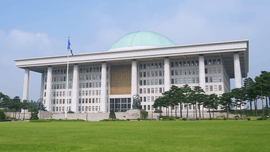 | |
|
National Assembly Building 37°31′55.21″N 126°54′50.66″E / 37.5320028°N 126.9140722°E | |
| Website | |
| korea.na.go.kr | |

The National Assembly of the Republic of Korea, often shortened to the National Assembly in domestic English-language media, is the 300-member[3] unicameral national legislature of South Korea. The latest legislative elections were held on 13 April 2016. Single-member constituencies comprise 253 of the assembly's seats, while the remaining 47 are allocated by proportional representation. Members serve four-year terms.
The unicameral assembly consists of at least 200 members according to the South Korean constitution. In 1990 the assembly had 299 seats, 224 of which were directly elected from single-member districts in the general elections of April 1988. Under applicable laws, the remaining seventy-five representatives were elected from party lists. By law, candidates for election to the assembly must be at least thirty years of age. As part of a political compromise in 1987, an earlier requirement that candidates have at least five years' continuous residency in the country was dropped to allow Kim Dae-Jung, who had spent several years in exile in Japan and the United States during the 1980s, to return to political life. The National Assembly's term is four years. In a change from the more authoritarian Fourth Republic and Fifth Republic (1972–80 and 1980–87, respectively), under the Sixth Republic, the assembly cannot be dissolved by the president.
Current composition
| Group | Floor leader | Seats | % of seats | |
|---|---|---|---|---|
| Saenuri | Chung Jin-suk | 128 | 42.7% | |
| Minjoo | Woo Sang-ho | 121 | 40.3% | |
| People's | Park Jie-won | 38 | 12.7% | |
| Justice | Roh Hoe-chan | 6 | 2.0% | |
| Independents | 7 | 2.3% | ||
| Total | 300 | 100.0% | ||
|
Notes:
| ||||
Structure and appointment
Speaker
The constitution stipulates that the assembly is presided over by a Speaker and two Deputy Speakers,[4] who are responsible for expediting the legislative process. The Speaker and Deputy Speakers are elected in a secret ballot by the members of the Assembly, and their term in office is restricted to two years.[5] The Speaker is independent of party affiliation, and the Speaker and Deputy Speakers may not simultaneously be government ministers.[5]
Negotiation groups
Parties that hold at least 20 seats in the assembly form floor negotiation groups (Korean: 교섭단체, RR: gyoseop danche), which are entitled to a variety of rights that are denied to smaller parties. These include a greater amount of state funding and participation in the leaders' summits that determine the assembly's legislative agenda.[6]
Legislative process
To introduce a bill, a legislator must present the initiative to the Speaker with the signatures of at least ten other members of the assembly. The bill must then be edited by a committee to ensure that the bill contains correct and systematic language. It can then be approved or rejected by the Assembly.[7]
Committees
There are 16 standing committees which examine bills and petitions falling under their respective jurisdictions, and perform other duties as prescribed by relevant laws.
- House Steering Committee
- Legislation and Judiciary Committee
- National Policy Committee
- Strategy and Finance Committee
- Science, ICT, Future Planning, Broadcasing and Communications Committee
- Education, Culture, Sports and Tourism Committee
- Foreign Affairs and Unification Committee
- National Defense Committee
- Security and Public Administration Committee
- Agriculture, Food, Rural Affairs, Oceans and Fisheries Committee
- Trade, Industry and Energy Committee
- Health and Welfare Committee
- Environment and Labor Committee
- Land, Infrastructure and Transport Committee
- Intelligence Committee
- Gender Equality and Family Committee
Election
Since the promulgation of the March 1988 electoral law, the assembly has been elected every four years through a Supplementary Member system, meaning that some of the members are elected from constituencies according to the system of first past the post, while others are elected at a national level through proportional representation.[8] As of 2012, 246 members represent constituencies, while 54 were elected from PR lists. In contrast to elections to the Assembly, presidential elections occur once every five years, and this has led to frequent situations of minority government and legislative deadlock.[9]
Reform proposals
A proposal to lower the number of seats required to form a negotiation group to 15 was passed on 24 July 2000, but was overturned by the Constitutional Court later that month.[10] In order to meet the quorum, the United Liberal Democrats, who then held 17 seats, arranged to "rent" three legislators from the Millennium Democratic Party. The legislators returned to the MDP after the collapse of the ULD–MDP coalition in September 2001.[11]
Legislative violence
From 2004 to 2009, the assembly gained notoriety as a frequent site for legislative violence.[12] The Assembly first came to the world's attention during a violent dispute on impeachment proceedings for then President Roh Moo-hyun,[13][14] when open physical combat took place in the assembly. Since then, it has been interrupted by periodic conflagrations, piquing the world's curiosity once again in 2009 when members battled each other with sledgehammers and fire extinguishers.[15][16][17][18] Images of the melee were broadcast around the world.
History
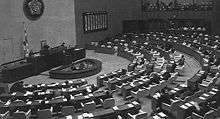
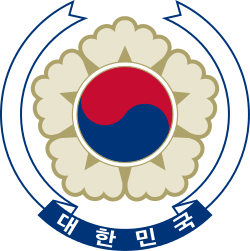 |
| This article is part of a series on the politics and government of South Korea |
| Constitution |
|
Judiciary 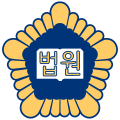
|
First Republic
Elections for the assembly were held under UN supervision[19] on 10 May 1948. The First Republic of South Korea was established on 17 July 1948[20] when the constitution of the First Republic was established by the Assembly. The Assembly also had the job of electing the President, and elected anti-communist Syngman Rhee as President on 10 May 1948.
Under the first constitution, the National Assembly was unicameral. Under the second and third constitutions, the National Assembly became bicameral and consisted of the House of Commons and the Senate, but actually unicameral with the House of Commons because the House of Commons could not pass a bill to establish the Senate.
Conservative Liberal Progressive
majority plurality only largest minority
| National Assembly |
Majority Party |
Majority Leader |
Seats | Speaker | Seats | Minority Leaders |
Minority Parties | ||
|---|---|---|---|---|---|---|---|---|---|
| 1st (1948) |
NARRKI→NA | 55 | 1948 Rhee Syng-man (supported by NARRKI) 1948–1950 Shin Ik-hee (supported by NARRKI until 1949) |
29 | KDP→DNP | ||||
| 116 | others | ||||||||
| 2nd (1950) |
DNP | 24 | Shin Ik-hee (supported by DNP) | 24 | KNP | ||||
| 14 | NA | ||||||||
| 148 | others | ||||||||
| 3rd (1954) |
LP | 114 | Yi Ki-bung (supported by LP) | 15 | DNP→DP (55) | ||||
| 3 | NA | ||||||||
| 3 | KNP | ||||||||
| 68 | others | ||||||||
| 4th (1958) |
LP | 126 | Yi Ki-bung (supported by LP) | 79 | DP (55) | ||||
| 28 | others | ||||||||
Second Republic
| House of Commons |
Majority Party |
Majority Leader |
Seats | Speaker | Seats | Minority Leaders |
Minority Parties | ||
|---|---|---|---|---|---|---|---|---|---|
| 5th (1960) |
DP (55) | 175 | Kwak Sang-hoon (supported by DP (55)) | 58 | Others | ||||
| Senate | Majority Party |
Majority Leader |
Seats | Speaker | Seats | Minority Leaders |
Minority Parties | ||
|---|---|---|---|---|---|---|---|---|---|
| 5th (1960) |
DP (55) | 31 | Baek Nak-jun (supported by DP (55)) | 27 | Others | ||||
Third Republic
Since the reopen of the National Assembly in 1963 until today, it has been unicameral.
| National Assembly |
Majority Party |
Majority Leader |
Seats | Speaker | Seats | Minority Leaders |
Minority Parties | ||
|---|---|---|---|---|---|---|---|---|---|
| 6th (1963) |
DRP | 110 | Lee Hyu-sang (supported by DRP) | 41 | CRP→PP→NDP | ||||
| 13 | DP (55)→PP→NDP | ||||||||
| 7th (1967) |
DRP | 129 | Lee Hyu-sang (supported by DRP) | 45 | NDP | ||||
| 8th (1971) |
DRP | 113 | Baek Du-jin (supported by DRP) | 89 | NDP | ||||
Fourth Republic
| National Assembly |
Majority Party |
Majority Leader |
Seats | Speaker | Seats | Minority Leaders |
Minority Parties | ||
|---|---|---|---|---|---|---|---|---|---|
| 9th (1973) |
DRP+Presidential appointees | 146 | Chung Il-kwon (supported by DRP) | 52 | NDP | ||||
| 10th (1978) |
DRP+Presidential appointees ↓ KNP |
145 | 1978–1879 Chung Il-kwon (supported by DRP) 1979 Baek Du-jin (supported by DRP) |
61 | NDP | ||||
Fifth Republic
| National Assembly |
Majority Party |
Majority Leader |
Seats | Speaker | Seats | Minority Leaders |
Minority Parties | ||
|---|---|---|---|---|---|---|---|---|---|
| 11th (1981) |
DJP | 151 | 1981–1983 Chung Rae-hyung (supported by DJP) 1983–1985 Chae Mun-shik (supported by DJP) |
81 | DKP | ||||
| 25 | KNP | ||||||||
| 12th (1985) |
DJP | 148 | Lee Jae-hyung (supported by DJP) | 67 | NKDP | ||||
| 35 | DKP | ||||||||
| 20 | KNP | ||||||||
Sixth Republic
| National Assembly |
Majority Party |
Majority Leader |
Seats | Speaker | Seats | Minority Leaders |
Minority Parties | ||
|---|---|---|---|---|---|---|---|---|---|
| 13th (1988) |
DJP ↓ DLP |
125↓ 219 |
1988–1990 Kim Jae-sun (supported by DJP→DLP) 1990–1992 Park Jyun-kyu (supported by DLP) |
70 | PPD→DP (91) | ||||
| 59↓ 0 |
RDP merge with DJP 1990 |
||||||||
| 35↓ 0 |
NDRP merge with DJP 1990 |
||||||||
| 14th (1992) |
DLP ↓ NKP |
149↓ 119 |
1992–1993 Park Jyun-kyu (supported by DLP) 1993 Hwang Nak-joo (supported by DP) 1993–1994 Lee Man-sup (supported by DLP) 1994–1996 Park Jyun-kyu (supported by DLP→NKP) |
97 | DP (91)→NCNP | ||||
| 0↓ 61 |
ULD split from DLP in 1995 |
||||||||
| 31↓ 0 |
UPP merge with ULD in 1995 |
||||||||
| 15th (1996) |
NKP ↓ GNP |
1999–2000 Lee Bu-young | 139 | 1996–1998 Kim Soo-han (supported by NKP→GNP) 1998–2000 Park Jyun-kyu (supported by GNP) |
79 | NCNP→MDP | |||
| 50 | ULD | ||||||||
| 15 | UDP (95)→DP (95) | ||||||||
| 16th (2000) |
GNP | 2000 Lee Bu-young 2000–2001 Jeon Chang-hwa 2001–2002 Lee Jae-oh 2002–2003 Lee Kyu-taek 2003–2004 Hong Sa-duk |
133↓ 150 |
2000–2002 Lee Man-sup (supported by MDP) 2002–2004 Park Kwan-yong (supported by GNP) |
115↓ 73 |
MDP | |||
| 0↓ 47 |
2003–2004 Kim Geun-tae | UP split from MDP in 2003 |
|||||||
| 17↓ 0 |
ULD merge with GNP in 2006 |
||||||||
| 17th (2004) |
UP ↓ UDP |
2004 Kim Geun-tae (UP) 2004–2005 Chun Jung-bae (UP) 2005–2006 Chung Sye-kyun (UP) 2006–2007 Kim Han-gil (UP) 2007–2008 Chang Young-dal (UP) 2007–2008 Kim Hyo-seuk (UDP) |
152 | 2004–2006 Kim Won-ki (supported by UP) 2006–2008 Lim Chae-jung (supported by UP→UDP) |
121 | 2004 Hong Sa-duk 2004–2005 Kim Deog-ryong 2005–2006 Kang Jae-sup 2006 Lee Jae-oh 2006–2007 Kim Hyong-o 2007–2008 Ahn Sang-soo |
GNP | ||
| 10 | DLP | ||||||||
| 18th (2008) |
GNP ↓ SP |
2008 Ahn Sang-soo 2008–2009 Hong Jun-pyo 2009–2010 Ahn Sang-soo 2010–2011 Kim Moo-sung 2011–2012 Hwang Woo-yea |
153 | 2008–2010 Kim Hyong-o (supported by GNP) 2010–2012 Park Hee-tae (supported by GNP) 2012–2012 Chung Eui-hwa (supported by GNP→SP) |
81 | 2008 Kim Hyo-seuk (UDP) 2008–2009 Won Hye-young (UDP→DP) 2009–2010 Lee Kang-lae (DP) 2010–2011 Park Jie-won (DP) 2011–2012 Kim Jin-pyo (DP→DUP) |
UDP→DP (08)→DUP | ||
| 18 | 2008–2010 Kwon Sun-taik 2010 Ryu Keun-chan 2010–2011 Kwon Sun-taik 2011–2012 Kim Nak-sung |
LFP | |||||||
| 5 | 2008 Kwon Young-ghil (DLP) 2008–2012 Kang Ki-kab (DLP→UPP) |
DLP→UPP | |||||||
| 14↓ 0 |
2008–2012 Roh Chul-Lae | PPC→FHA merge with SP in 2012 |
|||||||
| 19th (2012) |
SP | 2012 Hwang Woo-yea 2012–2013 Lee Hahn-koo 2013–2014 Choi Kyoung-hwan 2014–2015 Lee Wan-koo 2015 Yoo Seung-min 2015–2016 Won Yoo-chul |
152↓ 158↓ 160↓ 156↓ 157↓ 146↓ 145 |
2012–2014 Kang Chang-hee (supported by SP) 2014–2016 Chung Ui-hwa (supported by SP) |
127↓ 130↓ 111↓ 107↓ 102↓ 103 |
2012 Kim Jin-pyo (DUP) 2012 Park Jie-won (DUP) 2012–2013 Park Ki-choon (DUP→DP) 2013–2014 Jun Byung-hun (DP→NPAD) 2014 Park Young-sun (NPAD) 2014 Kim Yung-rok (NPAD) 2014–2015 Woo Yoon-keun (NPAD) 2015–2016 Lee Jong-kul (NPAD→MPK) |
DUP→DP (11)→NPAD→MPK | ||
| 18↓ 21↓ 20 |
2016 Joo Seung-yong | PP split from NPAD in 2016 |
|||||||
| 5 | 2012–2013 Kang Dong-won 2013–2015 Sim Sang-jung 2015–2016 Jeong Jin-hoo |
JP split from UPP in 2012 |
|||||||
| 1 | 2016 Shin Ki-nam | MP | |||||||
| 1↓ 0 |
2016 Lee Yoon-seok | CLP | |||||||
| 13↓ 5↓ 0 |
2012 Kang Ki-kab 2012–2014 Kim Seon-dong 2014 Oh Byung-yun |
UPP banned in 2014 |
|||||||
| 5↓ 0 |
2011–2012 Kim Nak-sung 2012 Sung Woan-jong |
LFP→AUP merge with SP in 2012 |
|||||||
| 20th (2016) |
SP | 2016- Chung Jin-suk | 122↓ 126↓ 129 |
2016- Chung Sye-kyun (supported by DPK) | 123↓ 122 |
2016- Woo Sang-ho | MP | ||
| 38 | 2016- Park Jie-won | PP | |||||||
| 6 | 2016- Roh Hoe-chan | JP | |||||||
Members
See also
- List of political parties in South Korea
- Supreme People's Assembly, the North Korean legislature
- Politics of South Korea
- List of Korea-related topics
- National Assembly
- Senate of South Korea
- House of Commons
- List of legislatures by country
References
- ↑ Speaker of Assembly can't join in a party. Formerly a member of Minjoo Party.
- ↑ "의석수 현황". National Assembly of South Korea. Retrieved 2016-05-04.
- ↑ Article 21, Clause 1 of the Election Law
- ↑ Article 48 of the Constitution of the Republic of Korea.
- 1 2 Park, Young-Do (2010). "Kapitel 2: Verfassungsrecht". Einführung in das koreanische Recht [Introduction to Korean Law] (in German). Springer. p. 25. ISBN 9783642116032.
- ↑ Youngmi Kim (2011). The Politics of Coalition in South Korea. Taylor & Francis, p. 65.
- ↑ Park 2010, p. 27.
- ↑ Aurel S. Croissant, "Electoral Politics of South Korea", in Croissant et al. (2002) Electoral Politics in Southeast and East Asia. Friedrich Ebert Foundation, p. 257.
- ↑ Croissant, p. 257.
- ↑ Y. Kim, p. 68.
- ↑ Y. Kim, pp. 68–9.
- ↑ World's Most Unruly Parliaments
- ↑ South Korean President Impeached
- ↑ Impeachment battle
- ↑ Democracy, South Korean-style: MPs blasted with fire extinguishers after trying to break into Parliament with hoses and sledgehammers
- ↑ South Korea lawmakers: Reaching across the aisle with a sledgehammer
- ↑ South Korean politicians use fire extinguishers against opposition
- ↑ Hall of Violence
- ↑ Setting the Stage
- ↑ ICL – South Korea Index
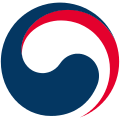
.svg.png)